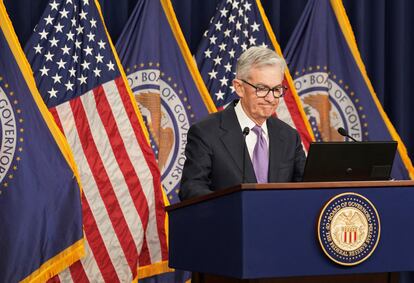Federal Reserve keeps key interest rate unchanged and foresees 3 rate cuts next year
The cuts suggest the officials think high borrowing rates will still be needed for much of next year to further slow spending and inflation

The Federal Reserve kept its key interest rate unchanged Wednesday for a third straight time, a sign that it is likely done raising rates after having imposed the fastest string of increases in four decades to fight painfully high inflation.
The Fed’s policymakers also signaled that they expect to make three quarter-point cuts to their benchmark interest rate next year. Those envisioned rate cuts — which wouldn’t likely begin until the second half of 2024 — suggest that the officials think high borrowing rates will still be needed for much of next year to further slow spending and inflation.
In a statement it issued after its 19-member policy committee met Wednesday, the Fed said “inflation has eased over the past year but remains elevated.” It was the first time since inflation first spiked in 2021 that the Fed has formally acknowledged progress in its fight against accelerating prices. It also provided a hint that its rate-cut efforts may be over, saying it is considering whether “any additional” hikes are needed.
The Fed kept its benchmark rate at about 5.4%, its highest level in 22 years, a rate that has led to much higher costs for mortgages, auto loans, business borrowing and many other forms of credit. Higher mortgage rates have sharply reduced home sales. Spending on appliances and other expensive goods that people often buy on credit has also declined.
So far, the Fed has achieved what few observers had thought possible a year ago: Inflation has tumbled without an accompanying surge in unemployment or a recession, which typically coincide with a central bank’s efforts to cool the economy and curb inflation. Though inflation remains above the Fed’s 2% target, it has declined faster than Fed officials had expected, allowing them to keep rates unchanged and wait to see if price increases continue to ease.
At the same time, the government’s latest report on consumer prices showed that inflation in some areas, particularly health care, apartment rents, restaurant meals and other services, remains persistently high, one reason why Fed Chair Jerome Powell is reluctant to signal that policymakers are prepared to cut rates anytime soon.
On Wednesday, the Fed’s quarterly economic projections showed that its officials envision a “soft landing” for the economy, in which inflation would continue its decline toward the central bank’s 2% target without causing a steep downturn. The forecasts showed that the policymakers expect to cut their benchmark rate to 4.6% by the end of 2024 — three quarter-point reductions from its current level.
A sharp economic slowdown could prompt even faster rate reductions. So far, though, there is no sign that a downturn is imminent.
In its quarterly projections, the Fed’s policymakers now expect “core” inflation, according to its preferred measure, to fall to just 2.4% by the end of 2024, down from a 2.6% forecast in September. Core inflation, which excludes volatile food and energy costs, is considered a better gauge to inflation’s future path.
The policymakers foresee unemployment rising to 4.1% next year, from its current 3.7%, which would still be a low level historically. They project that the economy will expand at a modest 1.4% next year and 1.8% in 2025.
Interest rate cuts by the Fed, whenever they happen, would reduce borrowing costs across the economy. Stock prices could rise, too, though share prices have already rallied in expectation of rate cuts, potentially limiting any further increases.
Powell, though, has recently downplayed the idea that rate reductions are nearing. He hasn’t yet even signaled that the Fed is conclusively done with its hikes.
One reason the Fed might be able to cut rates next year, even if the economy plows ahead, would be if inflation kept falling, as expected. A steady slowdown in price increases would have the effect of raising inflation-adjusted interest rates, thereby making borrowing costs higher than the Fed intends. Reducing rates, in this scenario, would simply keep inflation-adjusted borrowing costs from rising.
Recent economic data have modestly cooled financial markets’ expectations for early rate cuts. Last week’s jobs report for November showed that the unemployment rate fell to 3.7%, near a half-century low, down from 3.9% as businesses engaged in solid hiring. Such a low unemployment rate could force companies to keep raising pay to find and retain workers, which would fuel inflationary pressures.
And consumer prices were mostly unchanged last month, the government said Tuesday, suggesting that while inflation is likely headed back to the Fed’s 2% target, it might take longer than optimists expect. The central bank, as a result, could opt to keep rates at their current level to try to ensure that prices resume their downward path.
The Fed is the first of several major central banks to meet this week, with others also expected to keep their rates on hold. Both the European Central Bank and the Bank of England will decide on their next moves Thursday.
Sign up for our weekly newsletter to get more English-language news coverage from EL PAÍS USA Edition
Tu suscripción se está usando en otro dispositivo
¿Quieres añadir otro usuario a tu suscripción?
Si continúas leyendo en este dispositivo, no se podrá leer en el otro.
FlechaTu suscripción se está usando en otro dispositivo y solo puedes acceder a EL PAÍS desde un dispositivo a la vez.
Si quieres compartir tu cuenta, cambia tu suscripción a la modalidad Premium, así podrás añadir otro usuario. Cada uno accederá con su propia cuenta de email, lo que os permitirá personalizar vuestra experiencia en EL PAÍS.
¿Tienes una suscripción de empresa? Accede aquí para contratar más cuentas.
En el caso de no saber quién está usando tu cuenta, te recomendamos cambiar tu contraseña aquí.
Si decides continuar compartiendo tu cuenta, este mensaje se mostrará en tu dispositivo y en el de la otra persona que está usando tu cuenta de forma indefinida, afectando a tu experiencia de lectura. Puedes consultar aquí los términos y condiciones de la suscripción digital.
More information
Archived In
Últimas noticias
Most viewed
- Reinhard Genzel, Nobel laureate in physics: ‘One-minute videos will never give you the truth’
- Oona Chaplin: ‘I told James Cameron that I was living in a treehouse and starting a permaculture project with a friend’
- Pablo Escobar’s hippos: A serious environmental problem, 40 years on
- Why we lost the habit of sleeping in two segments and how that changed our sense of time
- Chevy Chase, the beloved comedian who was a monster off camera: ‘Not everyone hated him, just the people who’ve worked with him’










































